Detailed Analysis: Landfill Hazards and Innovative Technologies
VerifiedAdded on 2023/01/23
|8
|2107
|65
Report
AI Summary
This report delves into the hazards associated with landfills, primarily focusing on groundwater pollution caused by leachate. It highlights the composition of leachate, detailing the presence of hazardous chemicals, organic compounds, and heavy metals. The report also discusses the environmental problems stemming from landfills, such as air emissions and explosion hazards. Furthermore, it explores innovative technologies for leachate treatment, including air stripping and ozonation, providing detailed explanations of their mechanisms and effectiveness. The report emphasizes the importance of proper landfill management and the application of technologies to mitigate environmental risks and minimize the impact on groundwater quality. The report includes a detailed analysis of the technologies used in the treatment of landfill leachate and concludes with a discussion on the importance of the adoption of new technologies to reduce the impacts associated with landfilling.
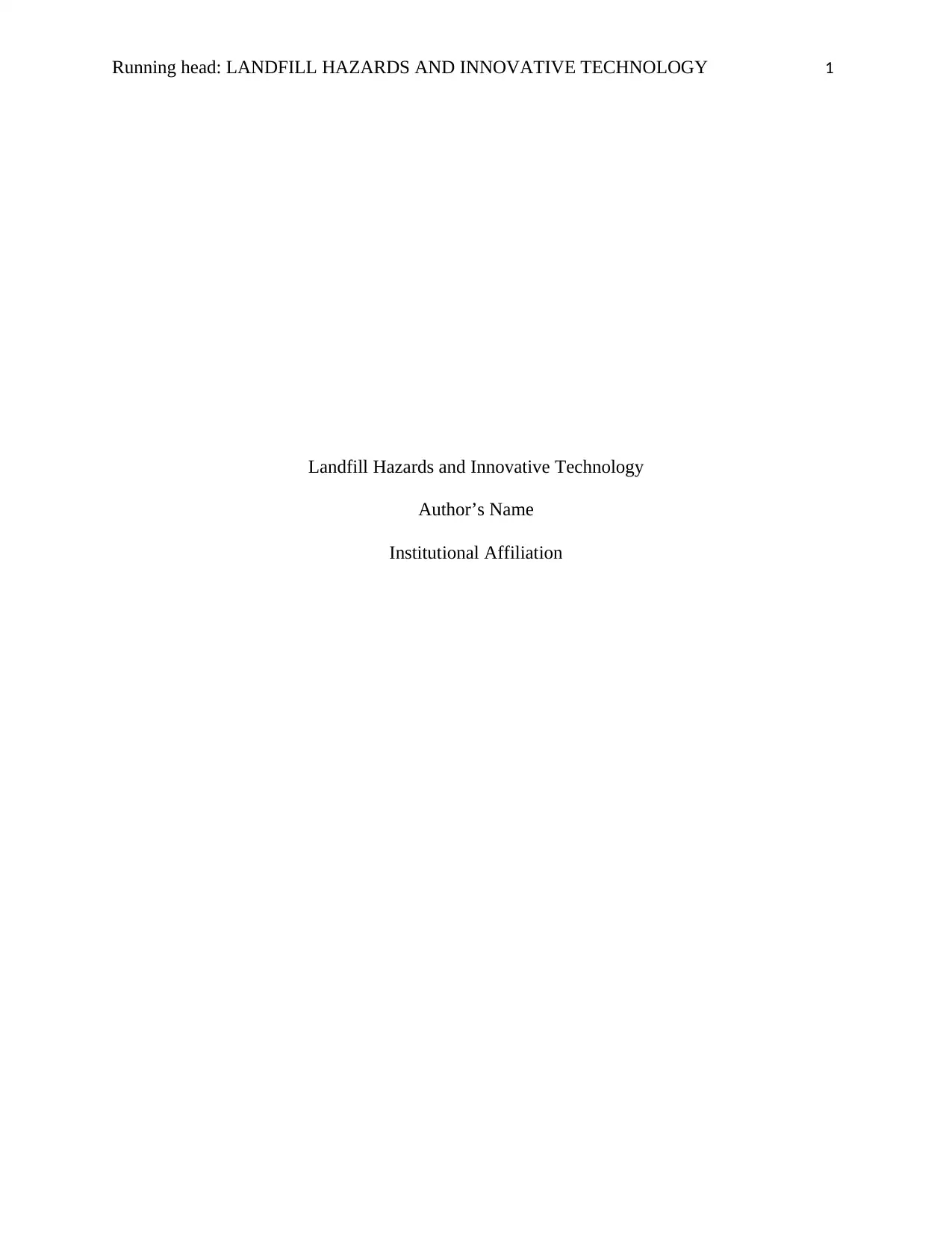
Running head: LANDFILL HAZARDS AND INNOVATIVE TECHNOLOGY 1
Landfill Hazards and Innovative Technology
Author’s Name
Institutional Affiliation
Landfill Hazards and Innovative Technology
Author’s Name
Institutional Affiliation
Paraphrase This Document
Need a fresh take? Get an instant paraphrase of this document with our AI Paraphraser
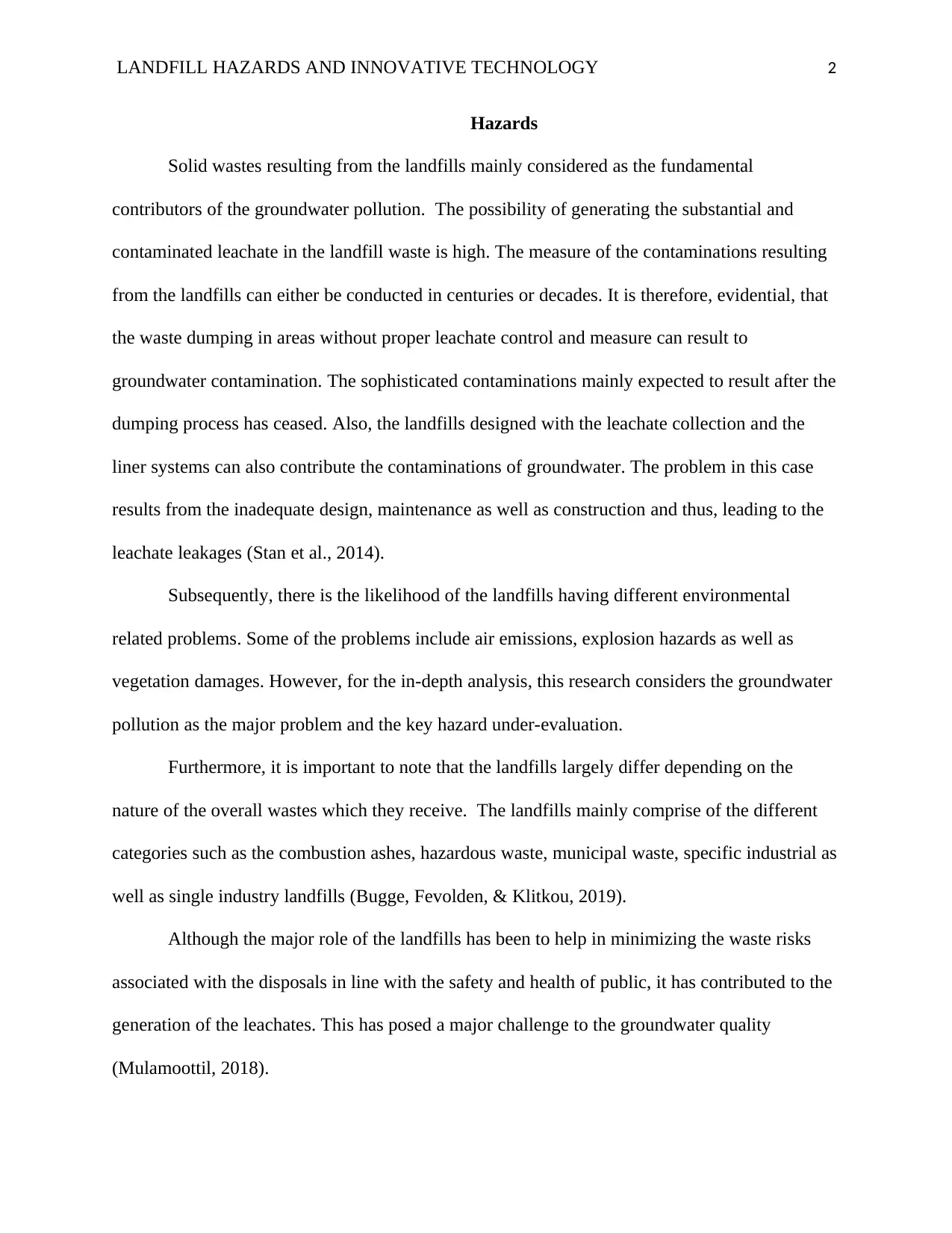
LANDFILL HAZARDS AND INNOVATIVE TECHNOLOGY 2
Hazards
Solid wastes resulting from the landfills mainly considered as the fundamental
contributors of the groundwater pollution. The possibility of generating the substantial and
contaminated leachate in the landfill waste is high. The measure of the contaminations resulting
from the landfills can either be conducted in centuries or decades. It is therefore, evidential, that
the waste dumping in areas without proper leachate control and measure can result to
groundwater contamination. The sophisticated contaminations mainly expected to result after the
dumping process has ceased. Also, the landfills designed with the leachate collection and the
liner systems can also contribute the contaminations of groundwater. The problem in this case
results from the inadequate design, maintenance as well as construction and thus, leading to the
leachate leakages (Stan et al., 2014).
Subsequently, there is the likelihood of the landfills having different environmental
related problems. Some of the problems include air emissions, explosion hazards as well as
vegetation damages. However, for the in-depth analysis, this research considers the groundwater
pollution as the major problem and the key hazard under-evaluation.
Furthermore, it is important to note that the landfills largely differ depending on the
nature of the overall wastes which they receive. The landfills mainly comprise of the different
categories such as the combustion ashes, hazardous waste, municipal waste, specific industrial as
well as single industry landfills (Bugge, Fevolden, & Klitkou, 2019).
Although the major role of the landfills has been to help in minimizing the waste risks
associated with the disposals in line with the safety and health of public, it has contributed to the
generation of the leachates. This has posed a major challenge to the groundwater quality
(Mulamoottil, 2018).
Hazards
Solid wastes resulting from the landfills mainly considered as the fundamental
contributors of the groundwater pollution. The possibility of generating the substantial and
contaminated leachate in the landfill waste is high. The measure of the contaminations resulting
from the landfills can either be conducted in centuries or decades. It is therefore, evidential, that
the waste dumping in areas without proper leachate control and measure can result to
groundwater contamination. The sophisticated contaminations mainly expected to result after the
dumping process has ceased. Also, the landfills designed with the leachate collection and the
liner systems can also contribute the contaminations of groundwater. The problem in this case
results from the inadequate design, maintenance as well as construction and thus, leading to the
leachate leakages (Stan et al., 2014).
Subsequently, there is the likelihood of the landfills having different environmental
related problems. Some of the problems include air emissions, explosion hazards as well as
vegetation damages. However, for the in-depth analysis, this research considers the groundwater
pollution as the major problem and the key hazard under-evaluation.
Furthermore, it is important to note that the landfills largely differ depending on the
nature of the overall wastes which they receive. The landfills mainly comprise of the different
categories such as the combustion ashes, hazardous waste, municipal waste, specific industrial as
well as single industry landfills (Bugge, Fevolden, & Klitkou, 2019).
Although the major role of the landfills has been to help in minimizing the waste risks
associated with the disposals in line with the safety and health of public, it has contributed to the
generation of the leachates. This has posed a major challenge to the groundwater quality
(Mulamoottil, 2018).
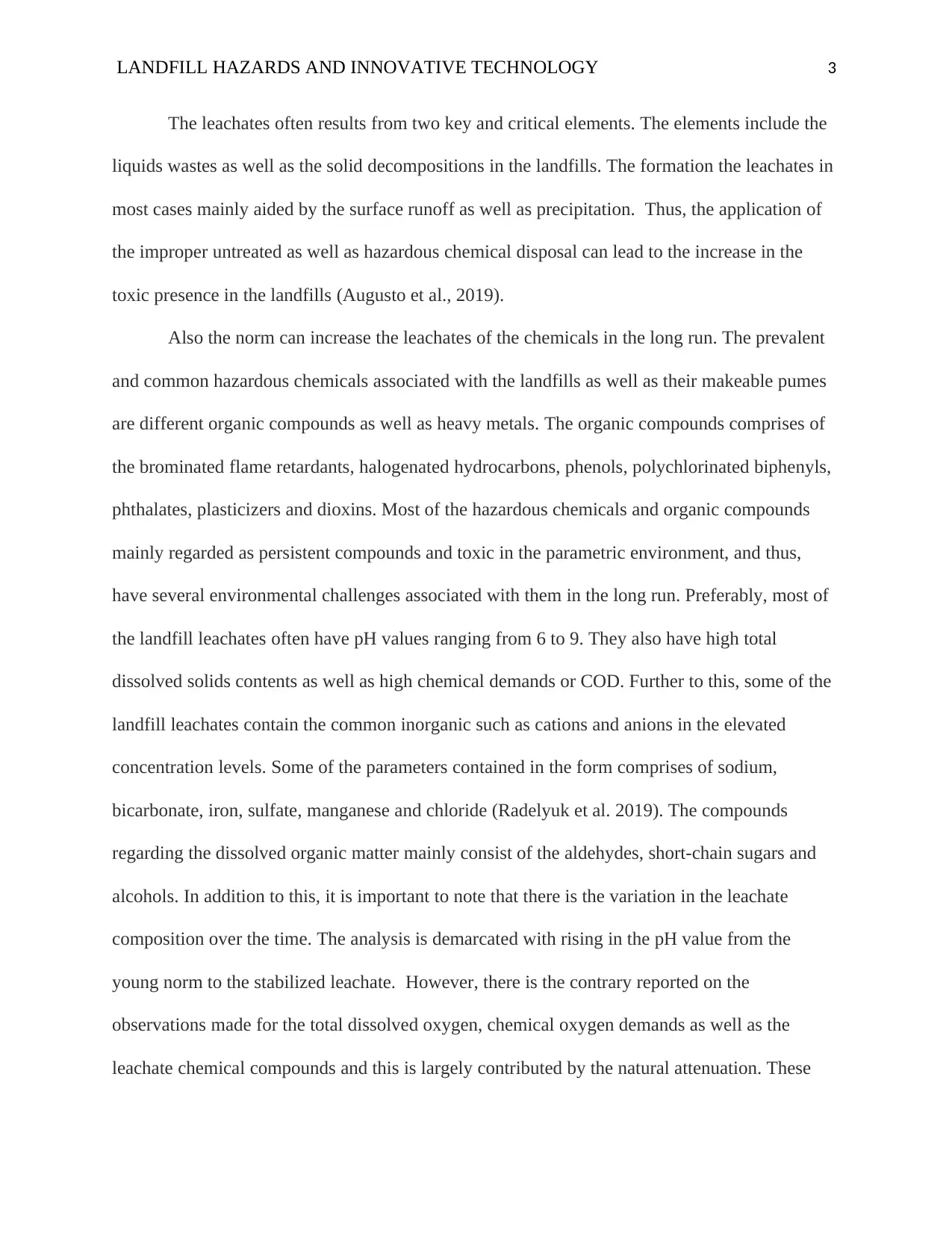
LANDFILL HAZARDS AND INNOVATIVE TECHNOLOGY 3
The leachates often results from two key and critical elements. The elements include the
liquids wastes as well as the solid decompositions in the landfills. The formation the leachates in
most cases mainly aided by the surface runoff as well as precipitation. Thus, the application of
the improper untreated as well as hazardous chemical disposal can lead to the increase in the
toxic presence in the landfills (Augusto et al., 2019).
Also the norm can increase the leachates of the chemicals in the long run. The prevalent
and common hazardous chemicals associated with the landfills as well as their makeable pumes
are different organic compounds as well as heavy metals. The organic compounds comprises of
the brominated flame retardants, halogenated hydrocarbons, phenols, polychlorinated biphenyls,
phthalates, plasticizers and dioxins. Most of the hazardous chemicals and organic compounds
mainly regarded as persistent compounds and toxic in the parametric environment, and thus,
have several environmental challenges associated with them in the long run. Preferably, most of
the landfill leachates often have pH values ranging from 6 to 9. They also have high total
dissolved solids contents as well as high chemical demands or COD. Further to this, some of the
landfill leachates contain the common inorganic such as cations and anions in the elevated
concentration levels. Some of the parameters contained in the form comprises of sodium,
bicarbonate, iron, sulfate, manganese and chloride (Radelyuk et al. 2019). The compounds
regarding the dissolved organic matter mainly consist of the aldehydes, short-chain sugars and
alcohols. In addition to this, it is important to note that there is the variation in the leachate
composition over the time. The analysis is demarcated with rising in the pH value from the
young norm to the stabilized leachate. However, there is the contrary reported on the
observations made for the total dissolved oxygen, chemical oxygen demands as well as the
leachate chemical compounds and this is largely contributed by the natural attenuation. These
The leachates often results from two key and critical elements. The elements include the
liquids wastes as well as the solid decompositions in the landfills. The formation the leachates in
most cases mainly aided by the surface runoff as well as precipitation. Thus, the application of
the improper untreated as well as hazardous chemical disposal can lead to the increase in the
toxic presence in the landfills (Augusto et al., 2019).
Also the norm can increase the leachates of the chemicals in the long run. The prevalent
and common hazardous chemicals associated with the landfills as well as their makeable pumes
are different organic compounds as well as heavy metals. The organic compounds comprises of
the brominated flame retardants, halogenated hydrocarbons, phenols, polychlorinated biphenyls,
phthalates, plasticizers and dioxins. Most of the hazardous chemicals and organic compounds
mainly regarded as persistent compounds and toxic in the parametric environment, and thus,
have several environmental challenges associated with them in the long run. Preferably, most of
the landfill leachates often have pH values ranging from 6 to 9. They also have high total
dissolved solids contents as well as high chemical demands or COD. Further to this, some of the
landfill leachates contain the common inorganic such as cations and anions in the elevated
concentration levels. Some of the parameters contained in the form comprises of sodium,
bicarbonate, iron, sulfate, manganese and chloride (Radelyuk et al. 2019). The compounds
regarding the dissolved organic matter mainly consist of the aldehydes, short-chain sugars and
alcohols. In addition to this, it is important to note that there is the variation in the leachate
composition over the time. The analysis is demarcated with rising in the pH value from the
young norm to the stabilized leachate. However, there is the contrary reported on the
observations made for the total dissolved oxygen, chemical oxygen demands as well as the
leachate chemical compounds and this is largely contributed by the natural attenuation. These
⊘ This is a preview!⊘
Do you want full access?
Subscribe today to unlock all pages.

Trusted by 1+ million students worldwide
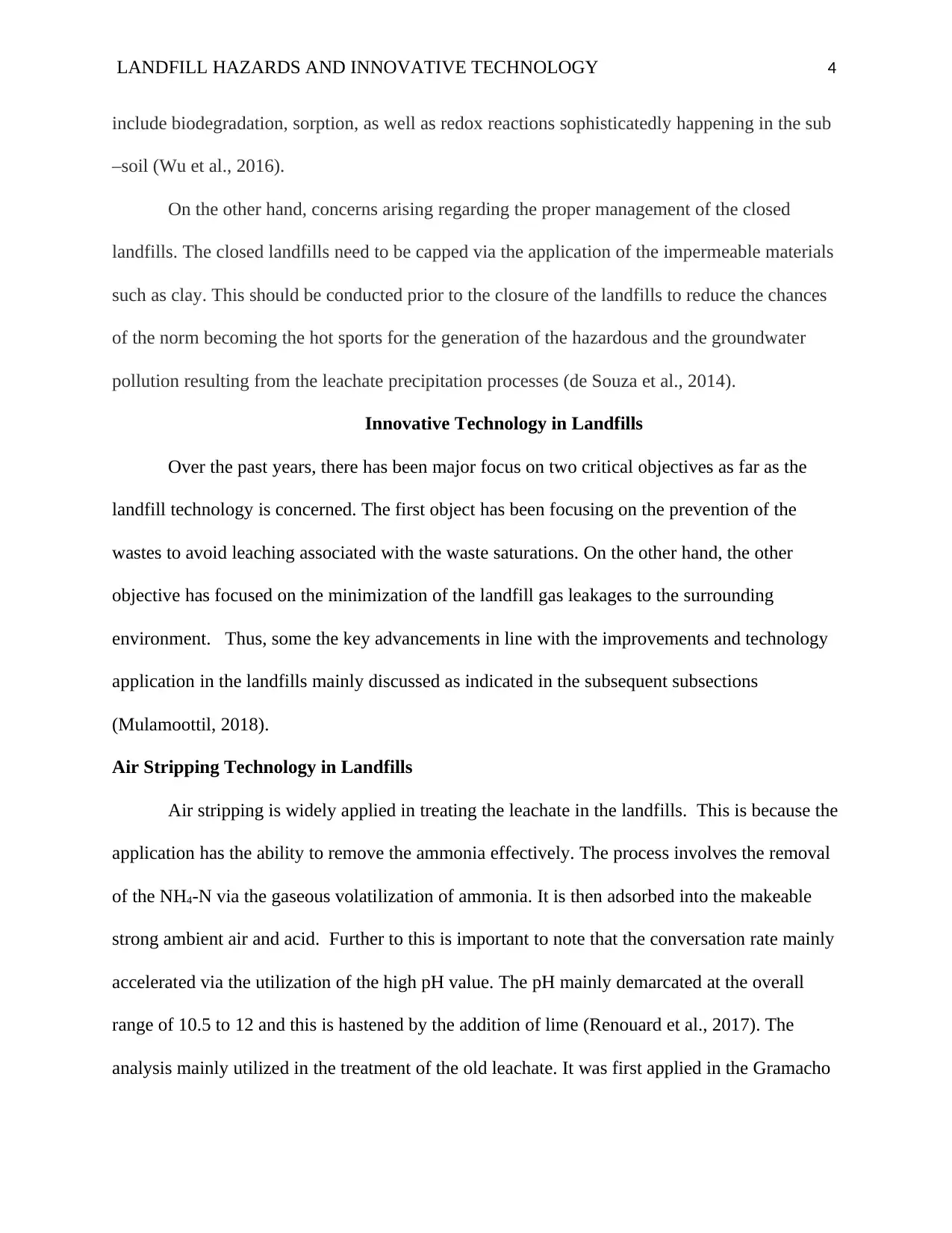
LANDFILL HAZARDS AND INNOVATIVE TECHNOLOGY 4
include biodegradation, sorption, as well as redox reactions sophisticatedly happening in the sub
–soil (Wu et al., 2016).
On the other hand, concerns arising regarding the proper management of the closed
landfills. The closed landfills need to be capped via the application of the impermeable materials
such as clay. This should be conducted prior to the closure of the landfills to reduce the chances
of the norm becoming the hot sports for the generation of the hazardous and the groundwater
pollution resulting from the leachate precipitation processes (de Souza et al., 2014).
Innovative Technology in Landfills
Over the past years, there has been major focus on two critical objectives as far as the
landfill technology is concerned. The first object has been focusing on the prevention of the
wastes to avoid leaching associated with the waste saturations. On the other hand, the other
objective has focused on the minimization of the landfill gas leakages to the surrounding
environment. Thus, some the key advancements in line with the improvements and technology
application in the landfills mainly discussed as indicated in the subsequent subsections
(Mulamoottil, 2018).
Air Stripping Technology in Landfills
Air stripping is widely applied in treating the leachate in the landfills. This is because the
application has the ability to remove the ammonia effectively. The process involves the removal
of the NH4-N via the gaseous volatilization of ammonia. It is then adsorbed into the makeable
strong ambient air and acid. Further to this is important to note that the conversation rate mainly
accelerated via the utilization of the high pH value. The pH mainly demarcated at the overall
range of 10.5 to 12 and this is hastened by the addition of lime (Renouard et al., 2017). The
analysis mainly utilized in the treatment of the old leachate. It was first applied in the Gramacho
include biodegradation, sorption, as well as redox reactions sophisticatedly happening in the sub
–soil (Wu et al., 2016).
On the other hand, concerns arising regarding the proper management of the closed
landfills. The closed landfills need to be capped via the application of the impermeable materials
such as clay. This should be conducted prior to the closure of the landfills to reduce the chances
of the norm becoming the hot sports for the generation of the hazardous and the groundwater
pollution resulting from the leachate precipitation processes (de Souza et al., 2014).
Innovative Technology in Landfills
Over the past years, there has been major focus on two critical objectives as far as the
landfill technology is concerned. The first object has been focusing on the prevention of the
wastes to avoid leaching associated with the waste saturations. On the other hand, the other
objective has focused on the minimization of the landfill gas leakages to the surrounding
environment. Thus, some the key advancements in line with the improvements and technology
application in the landfills mainly discussed as indicated in the subsequent subsections
(Mulamoottil, 2018).
Air Stripping Technology in Landfills
Air stripping is widely applied in treating the leachate in the landfills. This is because the
application has the ability to remove the ammonia effectively. The process involves the removal
of the NH4-N via the gaseous volatilization of ammonia. It is then adsorbed into the makeable
strong ambient air and acid. Further to this is important to note that the conversation rate mainly
accelerated via the utilization of the high pH value. The pH mainly demarcated at the overall
range of 10.5 to 12 and this is hastened by the addition of lime (Renouard et al., 2017). The
analysis mainly utilized in the treatment of the old leachate. It was first applied in the Gramacho
Paraphrase This Document
Need a fresh take? Get an instant paraphrase of this document with our AI Paraphraser
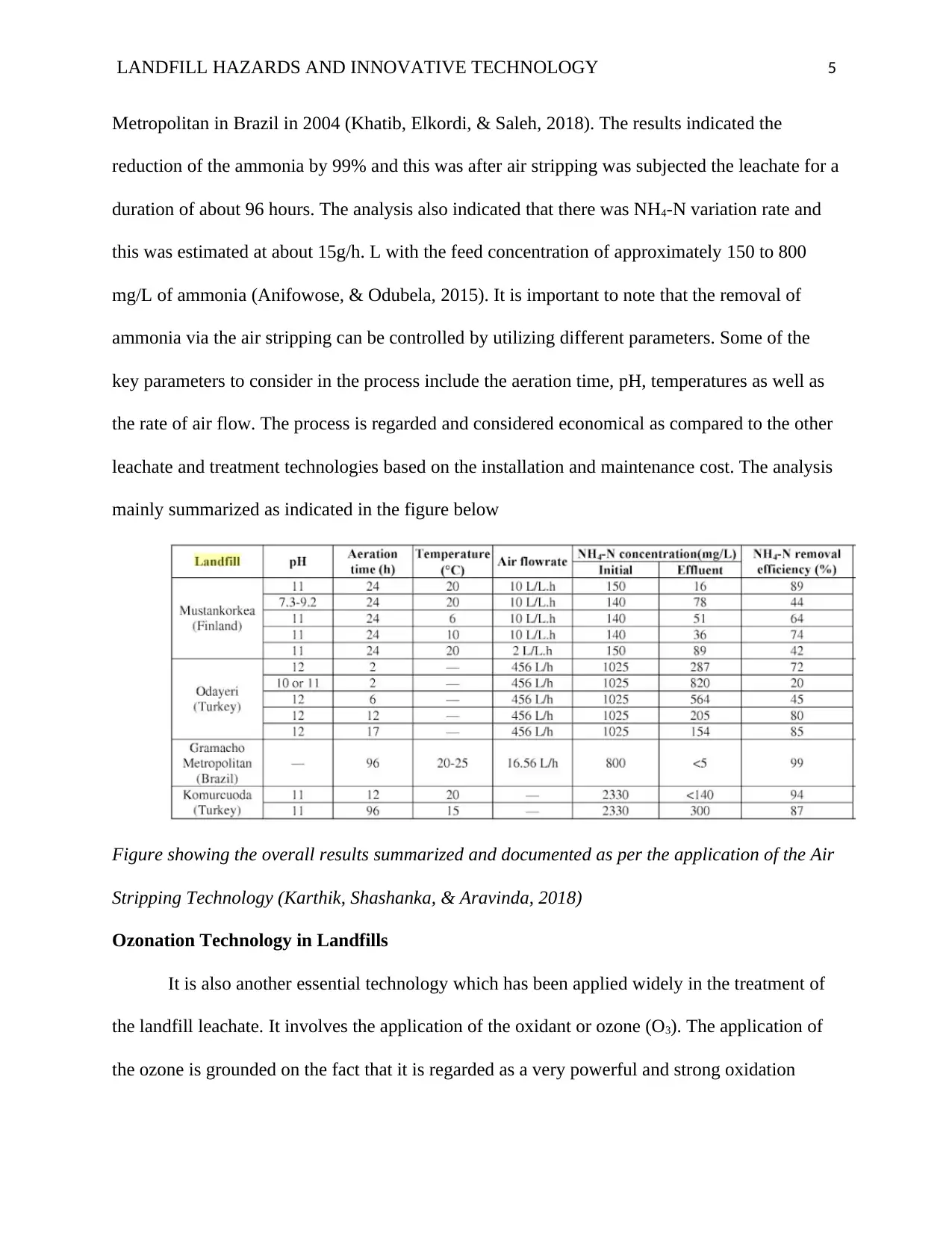
LANDFILL HAZARDS AND INNOVATIVE TECHNOLOGY 5
Metropolitan in Brazil in 2004 (Khatib, Elkordi, & Saleh, 2018). The results indicated the
reduction of the ammonia by 99% and this was after air stripping was subjected the leachate for a
duration of about 96 hours. The analysis also indicated that there was NH4-N variation rate and
this was estimated at about 15g/h. L with the feed concentration of approximately 150 to 800
mg/L of ammonia (Anifowose, & Odubela, 2015). It is important to note that the removal of
ammonia via the air stripping can be controlled by utilizing different parameters. Some of the
key parameters to consider in the process include the aeration time, pH, temperatures as well as
the rate of air flow. The process is regarded and considered economical as compared to the other
leachate and treatment technologies based on the installation and maintenance cost. The analysis
mainly summarized as indicated in the figure below
Figure showing the overall results summarized and documented as per the application of the Air
Stripping Technology (Karthik, Shashanka, & Aravinda, 2018)
Ozonation Technology in Landfills
It is also another essential technology which has been applied widely in the treatment of
the landfill leachate. It involves the application of the oxidant or ozone (O3). The application of
the ozone is grounded on the fact that it is regarded as a very powerful and strong oxidation
Metropolitan in Brazil in 2004 (Khatib, Elkordi, & Saleh, 2018). The results indicated the
reduction of the ammonia by 99% and this was after air stripping was subjected the leachate for a
duration of about 96 hours. The analysis also indicated that there was NH4-N variation rate and
this was estimated at about 15g/h. L with the feed concentration of approximately 150 to 800
mg/L of ammonia (Anifowose, & Odubela, 2015). It is important to note that the removal of
ammonia via the air stripping can be controlled by utilizing different parameters. Some of the
key parameters to consider in the process include the aeration time, pH, temperatures as well as
the rate of air flow. The process is regarded and considered economical as compared to the other
leachate and treatment technologies based on the installation and maintenance cost. The analysis
mainly summarized as indicated in the figure below
Figure showing the overall results summarized and documented as per the application of the Air
Stripping Technology (Karthik, Shashanka, & Aravinda, 2018)
Ozonation Technology in Landfills
It is also another essential technology which has been applied widely in the treatment of
the landfill leachate. It involves the application of the oxidant or ozone (O3). The application of
the ozone is grounded on the fact that it is regarded as a very powerful and strong oxidation

LANDFILL HAZARDS AND INNOVATIVE TECHNOLOGY 6
agent. Thus, it is applied in the treatment of the leachates which can lead to the contamination of
the groundwater. The application is essential as the element has the ability to transform the
contaminant decisively into the amicable innocuous components. The process lasts for a very
short period. It operates by altering the molecular structure of the parametric refractory of the
organic compounds. Thus, it transforms the element into the compounds which can easily be
assimilated in the biological processes. Thus, it applied in the biological treatment as a
fundamental parameter in the pretreatment process. It has also indicated that it can assist in the
degrading of the organic pollutants which are present in the overall leachate. Some of the organic
pollutants include the chlorophenols, polyaromatic as well as hydrocarbons. The analysis
regarding the overall performance of the element as far as the technology is concerned mainly
illustrated as tabulated in the table below.
Figure showing the overall results summarized and documented as per the application of the
Ozonation Technology (Gao et al., 2015)
agent. Thus, it is applied in the treatment of the leachates which can lead to the contamination of
the groundwater. The application is essential as the element has the ability to transform the
contaminant decisively into the amicable innocuous components. The process lasts for a very
short period. It operates by altering the molecular structure of the parametric refractory of the
organic compounds. Thus, it transforms the element into the compounds which can easily be
assimilated in the biological processes. Thus, it applied in the biological treatment as a
fundamental parameter in the pretreatment process. It has also indicated that it can assist in the
degrading of the organic pollutants which are present in the overall leachate. Some of the organic
pollutants include the chlorophenols, polyaromatic as well as hydrocarbons. The analysis
regarding the overall performance of the element as far as the technology is concerned mainly
illustrated as tabulated in the table below.
Figure showing the overall results summarized and documented as per the application of the
Ozonation Technology (Gao et al., 2015)
⊘ This is a preview!⊘
Do you want full access?
Subscribe today to unlock all pages.

Trusted by 1+ million students worldwide
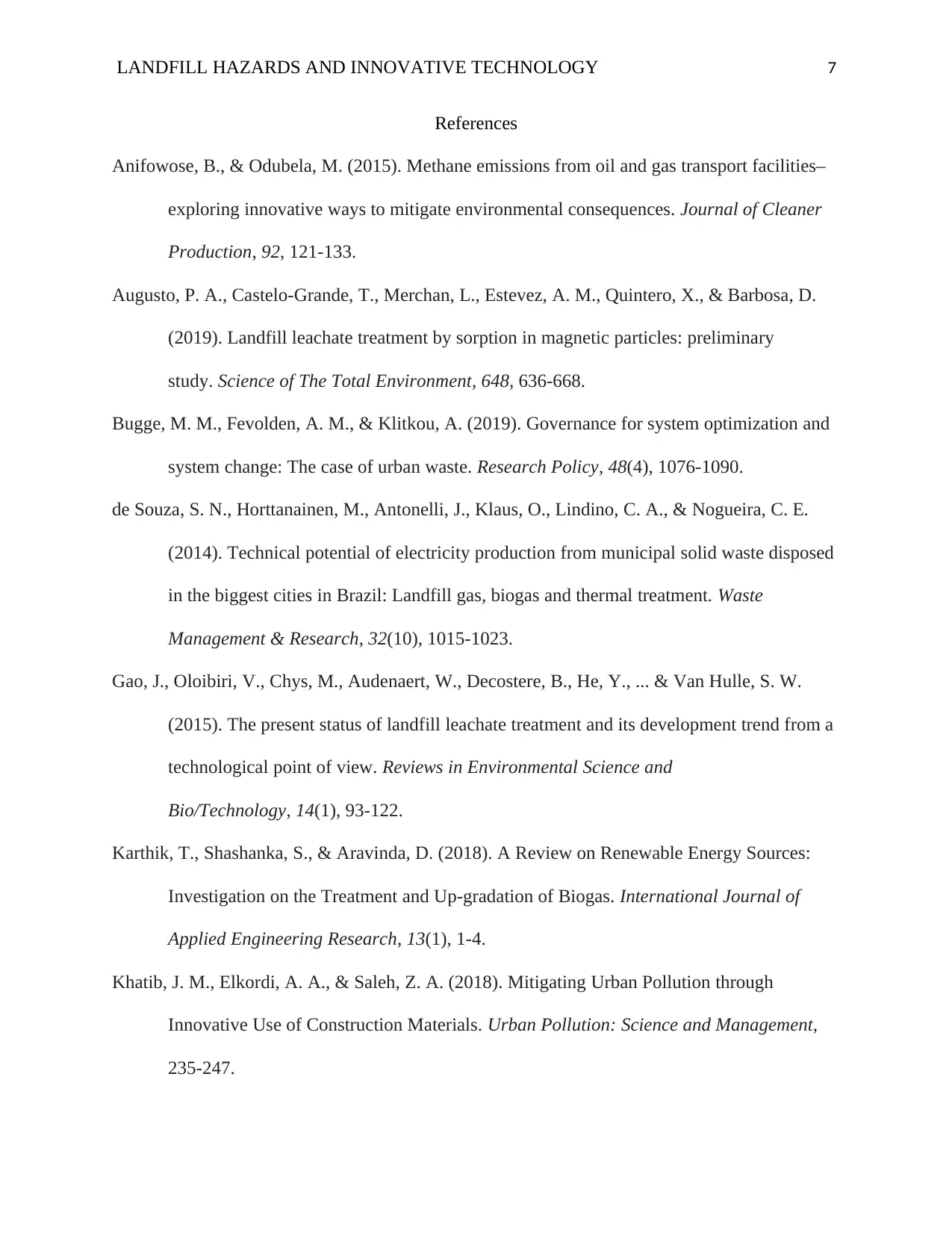
LANDFILL HAZARDS AND INNOVATIVE TECHNOLOGY 7
References
Anifowose, B., & Odubela, M. (2015). Methane emissions from oil and gas transport facilities–
exploring innovative ways to mitigate environmental consequences. Journal of Cleaner
Production, 92, 121-133.
Augusto, P. A., Castelo-Grande, T., Merchan, L., Estevez, A. M., Quintero, X., & Barbosa, D.
(2019). Landfill leachate treatment by sorption in magnetic particles: preliminary
study. Science of The Total Environment, 648, 636-668.
Bugge, M. M., Fevolden, A. M., & Klitkou, A. (2019). Governance for system optimization and
system change: The case of urban waste. Research Policy, 48(4), 1076-1090.
de Souza, S. N., Horttanainen, M., Antonelli, J., Klaus, O., Lindino, C. A., & Nogueira, C. E.
(2014). Technical potential of electricity production from municipal solid waste disposed
in the biggest cities in Brazil: Landfill gas, biogas and thermal treatment. Waste
Management & Research, 32(10), 1015-1023.
Gao, J., Oloibiri, V., Chys, M., Audenaert, W., Decostere, B., He, Y., ... & Van Hulle, S. W.
(2015). The present status of landfill leachate treatment and its development trend from a
technological point of view. Reviews in Environmental Science and
Bio/Technology, 14(1), 93-122.
Karthik, T., Shashanka, S., & Aravinda, D. (2018). A Review on Renewable Energy Sources:
Investigation on the Treatment and Up-gradation of Biogas. International Journal of
Applied Engineering Research, 13(1), 1-4.
Khatib, J. M., Elkordi, A. A., & Saleh, Z. A. (2018). Mitigating Urban Pollution through
Innovative Use of Construction Materials. Urban Pollution: Science and Management,
235-247.
References
Anifowose, B., & Odubela, M. (2015). Methane emissions from oil and gas transport facilities–
exploring innovative ways to mitigate environmental consequences. Journal of Cleaner
Production, 92, 121-133.
Augusto, P. A., Castelo-Grande, T., Merchan, L., Estevez, A. M., Quintero, X., & Barbosa, D.
(2019). Landfill leachate treatment by sorption in magnetic particles: preliminary
study. Science of The Total Environment, 648, 636-668.
Bugge, M. M., Fevolden, A. M., & Klitkou, A. (2019). Governance for system optimization and
system change: The case of urban waste. Research Policy, 48(4), 1076-1090.
de Souza, S. N., Horttanainen, M., Antonelli, J., Klaus, O., Lindino, C. A., & Nogueira, C. E.
(2014). Technical potential of electricity production from municipal solid waste disposed
in the biggest cities in Brazil: Landfill gas, biogas and thermal treatment. Waste
Management & Research, 32(10), 1015-1023.
Gao, J., Oloibiri, V., Chys, M., Audenaert, W., Decostere, B., He, Y., ... & Van Hulle, S. W.
(2015). The present status of landfill leachate treatment and its development trend from a
technological point of view. Reviews in Environmental Science and
Bio/Technology, 14(1), 93-122.
Karthik, T., Shashanka, S., & Aravinda, D. (2018). A Review on Renewable Energy Sources:
Investigation on the Treatment and Up-gradation of Biogas. International Journal of
Applied Engineering Research, 13(1), 1-4.
Khatib, J. M., Elkordi, A. A., & Saleh, Z. A. (2018). Mitigating Urban Pollution through
Innovative Use of Construction Materials. Urban Pollution: Science and Management,
235-247.
Paraphrase This Document
Need a fresh take? Get an instant paraphrase of this document with our AI Paraphraser

LANDFILL HAZARDS AND INNOVATIVE TECHNOLOGY 8
Mulamoottil, G. (2018). Constructed wetlands for the treatment of landfill leachates. Routledge.
Radelyuk, I., Tussupova, K., Zhapargazinova, K., Yelubay, M., & Persson, M. (2019). Pitfalls of
Wastewater Treatment in Oil Refinery Enterprises in Kazakhstan—A System
Approach. Sustainability, 11(6), 1618.
Renouard, N., Mérotte, J., Kervoëlen, A., Behlouli, K., Baley, C., & Bourmaud, A. (2017).
Exploring two innovative recycling ways for poly-(propylene)-flax non wovens
wastes. Polymer Degradation and Stability, 142, 89-101.
Stan, C., Apostol, T., Paraschiv, G., & Pásztai, Z. (2014). Two solutions for MSW treatment in
view of landfill minimization and energy recovery maximization. UPB Sci. Bull., Series
D, 76(4), 247-256.
Wu, H., Wang, J., Duan, H., Ouyang, L., Huang, W., & Zuo, J. (2016). An innovative approach
to managing demolition waste via GIS (geographic information system): a case study in
Shenzhen city, China. Journal of cleaner production, 112, 494-503.
Mulamoottil, G. (2018). Constructed wetlands for the treatment of landfill leachates. Routledge.
Radelyuk, I., Tussupova, K., Zhapargazinova, K., Yelubay, M., & Persson, M. (2019). Pitfalls of
Wastewater Treatment in Oil Refinery Enterprises in Kazakhstan—A System
Approach. Sustainability, 11(6), 1618.
Renouard, N., Mérotte, J., Kervoëlen, A., Behlouli, K., Baley, C., & Bourmaud, A. (2017).
Exploring two innovative recycling ways for poly-(propylene)-flax non wovens
wastes. Polymer Degradation and Stability, 142, 89-101.
Stan, C., Apostol, T., Paraschiv, G., & Pásztai, Z. (2014). Two solutions for MSW treatment in
view of landfill minimization and energy recovery maximization. UPB Sci. Bull., Series
D, 76(4), 247-256.
Wu, H., Wang, J., Duan, H., Ouyang, L., Huang, W., & Zuo, J. (2016). An innovative approach
to managing demolition waste via GIS (geographic information system): a case study in
Shenzhen city, China. Journal of cleaner production, 112, 494-503.
1 out of 8
Related Documents
Your All-in-One AI-Powered Toolkit for Academic Success.
+13062052269
info@desklib.com
Available 24*7 on WhatsApp / Email
![[object Object]](/_next/static/media/star-bottom.7253800d.svg)
Unlock your academic potential
Copyright © 2020–2025 A2Z Services. All Rights Reserved. Developed and managed by ZUCOL.





